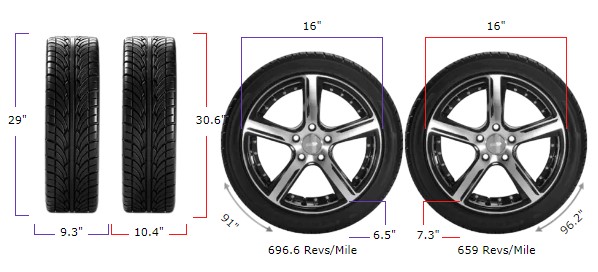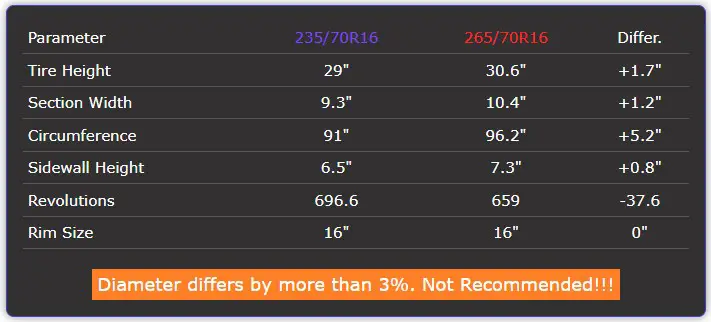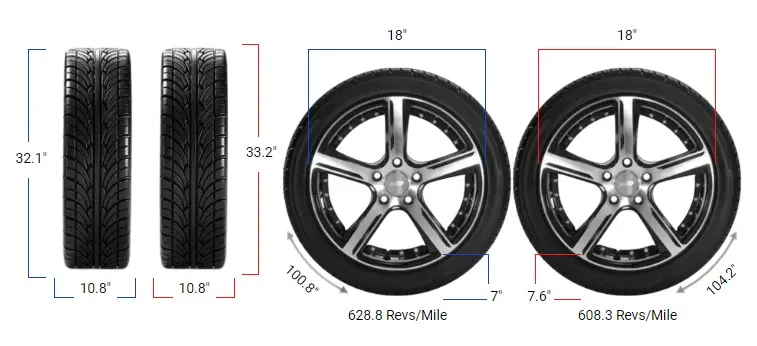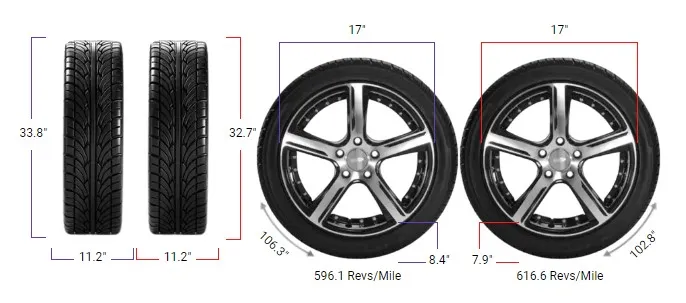Tire Size 235/70r16 vs 265/70r16

Thinking about upsizing your tires from 235/70r16 to 265/70r16? Bigger tires can change how your vehicle looks and drives. Let’s explore how this switch can affect your car both on and off the road.
Fitment Guide
Replacement tires should be within plus or minus 3% of the original tire’s diameter. If the diameter difference exceeds this range, the interchange is not recommended.
The 265/70r16 tires have a diameter difference of 5.7%, which goes beyond this limit. Using them without modifications could lead to problems like rubbing against the wheel wells or interfering with the suspension.
If you still want to switch to the larger size, you may need to make adjustments to your vehicle to prevent these issues.
On-Road Impact
Switching to larger tires can change how your vehicle behaves on city streets and highways. Let’s look at how this size change affects various aspects of your driving experience.
Ground Clearance
With larger tires, your vehicle sits higher off the ground. The sidewall height increases by 0.83 inches, which raises the entire vehicle by about that much.
This extra height can help you clear obstacles like speed bumps or potholes more easily. However, a higher center of gravity can make the vehicle feel less stable, especially during sharp turns or sudden maneuvers.

Gas Mileage
Bigger tires are usually heavier and have more rolling resistance. This means your engine has to work harder to move the vehicle, leading to decreased fuel efficiency.
You might notice a drop in gas mileage, which can add up over time and increase your fuel costs.
Aesthetic Look
Many drivers like the look of larger tires. The wider and taller 265/70r16 tires can give your vehicle a more robust and aggressive appearance. If you enjoy customizing your vehicle’s look, this might be a benefit worth considering.
Ride Comfort
Larger tires can change how your vehicle feels on the road. The increased sidewall height can absorb bumps better, potentially providing a smoother ride on rough roads.
On the other hand, the added weight of the tires can make the steering feel heavier and less responsive.

Speedometer Accuracy
When you install larger tires, your speedometer may no longer show the correct speed. Because the tires are bigger, they cover more distance with each rotation.
For example, when your speedometer reads 60 mph, you might actually be traveling at about 63.4 mph. This 5.7% difference means you could unintentionally exceed speed limits, which could result in tickets or unsafe driving conditions.
Durability & Wear
Wider tires distribute the vehicle’s weight over a larger area, which can reduce wear on the tread. However, this benefit may be small in everyday driving conditions. Factors like tire quality, road conditions, and driving habits have a bigger impact on how long your tires last.
Braking Performance
Larger tires can affect how your vehicle stops. The increased diameter can result in longer braking distances because the brakes have to work harder to slow down the heavier, larger-diameter tires. This can be critical in emergency situations where every foot counts.

Acceleration
Bigger tires can also impact acceleration. The added weight and larger diameter can make your vehicle accelerate more slowly. If you often merge onto highways or need quick acceleration, this is something to consider.
Handling and Steering
The wider tires increase the contact area with the road, which can improve traction. However, they can also make steering feel heavier and less precise. This can affect how the vehicle handles, especially during quick maneuvers or in tight spaces.
Off-Road Impact
For those who enjoy taking their vehicle off the beaten path, larger tires can offer some advantages. Let’s explore how the switch affects off-road performance.
Improved Traction
Wider tires have a bigger footprint, which can provide better grip on loose surfaces like dirt, mud, or sand. This improved traction can help you navigate challenging terrains more effectively.
Increased Ground Clearance
The larger diameter of the 265/70r16 tires raises your vehicle’s ground clearance by about 0.83 inches.
This extra height can help you clear rocks, roots, and other obstacles that you might encounter off-road, reducing the risk of underbody damage.
Departure Angles
With the vehicle sitting higher, you can achieve better approach and departure angles. This means you can tackle steeper inclines and declines without scraping the front or rear of your vehicle.
Potential for Rubbing
Without proper modifications, larger tires might rub against the wheel wells, fenders, or suspension components when driving over uneven terrain. This can cause damage to both the tires and your vehicle, potentially leading to costly repairs.
Suspension Stress
Heavier tires put more strain on suspension parts like shocks, springs, and bushings. When off-roading, the extra stress from rough terrain combined with heavier tires can accelerate wear and tear on these components.
Steering Effort
In off-road situations, precise steering is important. Larger, heavier tires can make steering more difficult, especially at low speeds or when maneuvering around obstacles. This increased effort can make off-roading more tiring.
Impact on Gear Ratios
Larger tires effectively change your vehicle’s gear ratios. This can result in less torque at the wheels, making it harder to climb steep hills or pull through deep mud. You may need to adjust your gearing to compensate for this change.
235/70r16 vs 265/70r16
| Feature | 235/70R16 | 265/70R16 | Difference |
|---|---|---|---|
| Diameter inches (mm) | 28.95 (735.4) | 30.61 (777.4) | 1.65 (42) +5.7% |
| Width inches (mm) | 9.25 (235) | 10.43 (265) | 1.18 (30) +12.8% |
| Circumference inches (mm) | 90.96 (2310.33) | 96.15 (2442.27) | 5.19 (131.95) +5.7% |
| Sidewall Height inches (mm) | 6.48 (164.5) | 7.3 (185.5) | 0.83 (21) +12.8% |
| Revolutions per mile (km) | 696.59 (432.84) | 658.95 (409.45) | -37.63 (-23.38) -5.4% |
| Speedo Reading | 20 mph | 21.14 mph | +1.14 mph |
Difference Between 235/70r16 and 265/70r16
The main difference between the 235/70r16 and 265/70r16 tires is their size. The 265/70r16 is wider by 30 mm (about 1.18 inches) and taller by 1.65 inches.
This results in a 5.7% larger diameter, which is more than the recommended 3% limit for changing tire sizes.
Can I Use 265/70r16 Instead of 235/70r16?
No, using 265/70r16 tires instead of 235/70r16 is not recommended. The diameter difference exceeds the safe limit, potentially affecting handling and safety.
How Much Taller Is a 265/70r16 Tire Than a 235/70r16?
A 265/70r16 tire is approximately 1.65 inches taller than a 235/70r16 tire. This height increase can enhance ground clearance and off-road capabilities.
How Much Wider is a 265/70r16 Tire Than a 235/70r16?
The 265/70r16 tire is about 1.18 inches wider than the 235/70r16 tire. This added width improves traction and stability on the road.
Our Observation
Switching from 235/70r16 to 265/70r16 tires offers a mix of benefits and drawbacks. On the positive side, the larger tires provide increased ground clearance and improved off-road capabilities like better traction and obstacle clearance. They can also enhance the vehicle’s appearance, giving it a more rugged look.
However, the 5.7% increase in diameter exceeds the recommended 3% limit, which can lead to several issues. On-road, you may experience decreased fuel efficiency, altered speedometer readings, heavier steering, and longer braking distances. These changes can affect daily driving comfort and safety.
Off-road, while you gain some advantages, you also risk potential rubbing and added stress on suspension components. The difference in size may require vehicle modifications to prevent problems, which can be an additional expense.
Overall, the impact of switching to larger tires depends on how you use your vehicle. If you primarily drive on-road and value fuel efficiency and handling, the negatives may outweigh the positives.
For off-road enthusiasts willing to make necessary adjustments, the benefits might be worth the trade-offs. It’s important to carefully consider your needs and possibly consult a professional before making the switch.




